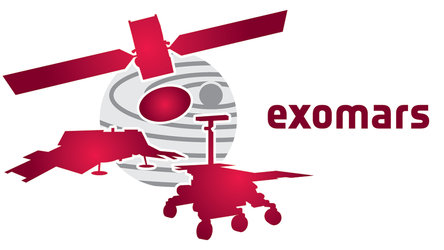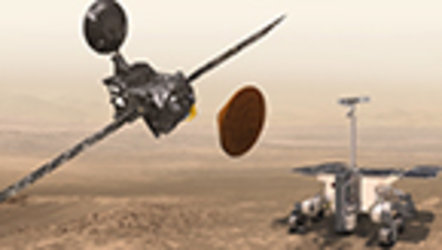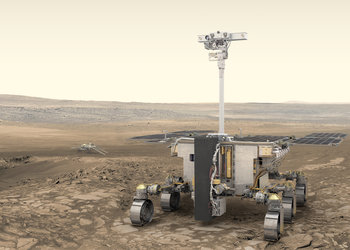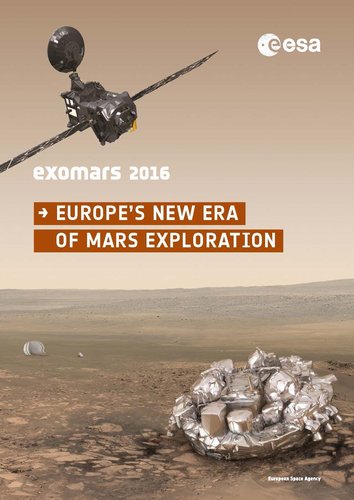ExoMars 2016 FAQs
Why is the mission called ExoMars?
The ‘Exo’ in ‘ExoMars’ refers to the study of ‘exobiology’, the possible existence of life beyond Earth (sometimes also referred to as ‘astrobiology’). Mars shows evidence for having had environmental conditions (suitable temperatures and liquid water) early in its history, some 3.5 billion years ago, capable of supporting primitive life. The primary goal of the ExoMars programme is to search for signs of past and extant life on Mars, hence the name.
What is the significance of the ‘2016’?
The ExoMars programme comprises two missions. The first launched on 14 March 2016 and consists of the Trace Gas Orbiter (TGO) and the Entry, descent and landing Demonstrator Module (EDM, also known as Schiaparelli). The second launch is planned for 2022 and will include two elements on the surface of Mars, namely a rover and a fixed science platform. TGO will also act as a communications relay for the 2022 rover.
What are the primary objectives of ExoMars 2016?
The main scientific objective of the Trace Gas Orbiter is to measure the abundance of methane and other trace gases in the martian atmosphere, and their geographical and seasonal distributions. These gases could be signatures of active or past biological processes on Mars, and TGO aims to distinguish between these processes and purely geological alternatives. The core purpose of Schiaparelli is as an engineering demonstrator testing key technologies in preparation for ESA’s contribution to subsequent missions to Mars, but it also includes a small scientific package for atmospheric studies.
What is a trace gas?
A trace gas makes up less than 1% by volume of a planet’s atmosphere. Methane is a trace gas in the Earth’s atmosphere, comprising around 1.8 parts per million by volume (0.00018%) and other trace gases on Earth include argon, carbon dioxide, and neon. In the much lower density martian atmosphere, methane comprises around 10 parts per billion by volume. Other trace gases on Mars include water vapour, nitrogen dioxide, and acetylene.
Why is methane important?
On Earth, most methane is produced as a by-product of microbial metabolism in the decomposition of biomass by single-celled organisms known as methanogens from the ancient Archaea family, distinct from bacteria and eukaryotes. A well-known example occurs in the stomachs of ruminants such as cows and sheep, where cellulose from grass is broken down in an anaerobic environment with the help of methanogens.
Methanogens are believed to have evolved on Earth several billion years ago, before the Earth built up oxygen in its atmosphere. Since Mars has never had an oxygenated atmosphere, methane in its atmosphere could betray the existence of life similar to Archaea that developed when Mars was warmer and wetter.
However, methane is also released on the Earth by naturally occurringhydrocarbongas reservoirs, and a contribution is also provided by volcanic and hydrothermal activity. Distinguishing between these potential processes on Mars is a priority for TGO.
In more detail, methane on Mars is destroyed by ultraviolet light from the Sun and expected to have a short lifetime of around 400 years. Also, atmospheric mixing should quickly lead to a more or less uniform background concentration. But previous measurements by ESA’s Mars Express mission and ground-based observatories hint at seasonal variations in methane abundance, with concentrations varying with location and time. Therefore, on one hand there must be active sources of methane to replenish the supply and on the other, there must a relatively quick way of removing it in order to account for the apparent variations in the measurements. Understanding the processes at play is a goal of the Trace Gas Orbiter mission.
What are the possible sources and sinks of methane on Mars?
The two main potential sources of methane on Mars are biological and geological. Subsurface microbes could be generating methane directly, pointing to present-day life. But methane could also have been produced millions of years in the past and become trapped in clathrate hydrates (a crystal-like structure of water, similar to ice), only to be released today.
Methane can also be produced by non-biological reactions between water and a mineral called olivine (a process called ‘serpentinisation’). On Mars, this may occur underground, perhaps in combination with warmer, volcanic environments.
Methane is broken down over time by ultraviolet radiation, oxidising it through chemical reactions into carbon dioxide, the primary ingredient of the martian atmosphere. In addition, winds on Mars can redistribute the methane from its original source, reducing localised concentrations.
What are the contributions of ESA and Roscosmos to the ExoMars programme?
The ExoMars programme is a cooperation between ESA and the Russian space agency, Roscosmos. Roscosmos is providing the Proton rockets to launch both missions to Mars, along with contributions to the scientific payload. On the 2016 mission, two of the four science instrument packages on the TGO are European-led and two are Russian-led, while the Schiaparelli package is European-led. The 2022 mission comprises a European-led rover and a Russian-led surface science platform. NASA also contributes some equipment to both missions.
Who are the ExoMars programme industrial partners?
The prime contractor is Thales Alenia Space Italia, leading an industrial team with contractors from many ESA Member and Cooperating States. These are: Austria, Belgium, Denmark, Finland, France, Germany, Greece, Italy, Portugal, Spain, Sweden, Netherlands, Norway, Poland, Switzerland, and the United Kingdom. Participating countries outside Europe are Russia, the United States, Canada, and Israel.
How did the ExoMars programme begin and how did it evolve?
ExoMars was conceived in 2001 as part of an ambitious ESA programme called Aurora with the long-term objective of human exploration of Mars. Initially, Aurora was planned around two robotic missions: a combined rover and orbiter mission for launch in 2009, and a Mars sample return mission at a later stage.
Delays ensued and the plans changed. In 2009, a cooperative agreement between NASA and ESA was signed, stating that the two agencies would undertake further robotic Mars exploration together. The design of the first mission was altered from the original ESA plans. It became a European-built orbiter tasked with the detection and mapping of trace gases in the martian atmosphere, and a landing demonstrator module, aimed to demonstrate the European technology needed for successful Mars landing. The mission would be launched in 2016, serving as a data relay for future surface missions.
The European rover and a similarly-sized US rover would then be landed two years later using NASA’s Skycrane system, as successfully used to deploy the Curiosity rover on Mars in 2012. This was found to be too challenging and rather a single large, Curiosity rover-like concept was envisaged, accommodating the European drill and payload along with US instruments.
In this scenario, NASA was to provide the launch vehicle and two of the four scientific instruments for the orbiter. However, NASA pulled out of the ExoMars programme in 2012 due to budgetary constraints.
Subsequent negotiations between ESA and Roscosmos led to an agreement for a new partnership for ExoMars. In this cooperation, Russia provides the two launch vehicles and various payload elements, with the original 2016 launch opportunity for the first mission staying intact.
Will there be any Aurora mission beyond ExoMars?
There are several mission studies undertaken within the Aurora programme to define the follow-up missions, ultimately aiming at preparing for European contributions to an international Mars sample return mission. For example, Phobos Sample Return is currently studied in an industrial Phase A study for a launch in 2024. Cooperation on NASA Mars missions is also considered. The ESA member states will have to decide when the implementation of a new mission will be started.
How will the results of ExoMars compare with previous Mars missions?
The ExoMars programme marks a new era of Mars exploration. The Planetary Fourier Spectrometer (PFS) of ESA’s Mars Express spacecraft was the first to discover methane, but the detections were at the limits of its sensitivity, and initially controversial. Similar spacecraft and ground-based measurements have also proven challenging. However, TGO has the capability to detect and analyse methane and other trace gases with a sensitivity three orders of magnitude better than the best previous measurements.
In more detail, TGO will be able to detect key isotopologues of methane and water. Isotopologues are molecules in which at least one atom has a different number of neutrons than in the parent molecule: for example, HDO is an isotopologue of H2O, where on hydrogen atom has been replaced by a deuterium atom. Measurements of methane on Earth suggest that methane originating from biological and geological processes have distinctive isotopic signatures, and thus TGO’s measurements will be key in constraining the origin and history of these species on Mars.
TGO also has the capability to detect additional minor atmospheric constituents that may exist but have yet to be detected.
While TGO will search for tracers of life or geological activity from orbit, the 2022 mission will be the first to combine roving over the martian surface with drilling and sampling material from a depth of up to two metres below the surface, in order to search for evidence of past or extant life protected from the harsh radiation environment present on the planet’s surface today.
Are there other missions to study the martian atmosphere? How do they complement TGO?
There are other missions, for example NASA’s MAVEN, which concentrates on atmospheric escape. This is something that also TGO addresses. Since the two orbits are very different, we will effectively have two measurement possibilities that will allow us compare results.
How will ExoMars operate in conjunction with Mars Express?
Although Mars Express will be following the entry, descent and landing sequence of Schiaparelli, it will not work in conjunction with ExoMars. The two mission science teams have met and discussed areas where they can both work together, for example to coordinate certain observations, but the missions are not operated together.
How were/will the ExoMars missions be launched?
TGO and Schiaparelli were launched together on a Russian four-stage Proton-M/Breeze-M launch vehicle from the Baikonur Cosmodrome in Kazakhstan. The 2022 mission will also be launched on a Proton.
What is the mission launch weight?
The total launch mass of ExoMars 2016 is 4332 kg, including fuel. The TGO mass is 3732 kg (including 112 kg of science payload) and Schiaparelli is 577 kg.
How big are the spacecraft?
The main body of TGO is 3.5 x 2 x 2 m, with solar arrays that span 17.5 m. Schiaparelli measures about 1.65 m across and roughly 2.4 m across when inside its heat shield.
When was the mission launched?
The ExoMars 2016 mission was launched on 14 March, at the start of a launch window that was open until 25 March 2016.
Is the launch insured?
No, it is not ESA policy to insure science missions.
What is the cost of the two missions?
The European cost of the ExoMars programme is €1.3 billion (under economic conditions of 2008), assuming launches in 2016 and 2022.
How long will it take to reach Mars?
Regardless of when the mission would have launched in the 14–25 March 2016 launch window, the mission will arrive at Mars on the same date, with the separation of TGO and Schiaparelli taking place on 16 October 2016, and Schiaparelli entering the martian atmosphere and landing on the surface on 19 October 2016.
In what orbit will ExoMars TGO operate?
After separation in October 2016, TGO will enter into an elliptical 4-day orbit around Mars that will take it from about 300 km at its nearest to 96 000 km at its furthest. In January 2017, TGO will perform two large manoeuvres: the first will increase its orbital inclination with respect to the Mars equator to 74 degrees so that science observations can cover most of the planet, not just the equatorial regions where Schiaparelli will land.
The second phase will take up to one year, and consist of hundreds of ‘aerobraking’ passes, a process that involves lowering the lowest point of the orbit (‘periares’) such that it grazes the upper atmosphere. Every time the spacecraft flies through this part of its orbit, it will be slowed down a small amount by air drag. After many hundreds of orbits doing this, it will eventually arrive in its circular science orbit 400 km above the surface.
What is the scientific payload of the TGO?
TGO has four instruments comprising two spectrometers (ACS and NOMAD), a neutron detector (FREND), and an imaging system (CaSSIS). In brief, ACS (operating in the near- to thermal-infrared) and NOMAD (operating in the ultraviolet/visible/near-infrared) will make a detailed inventory of Mars’ atmospheric trace gases, and will monitor seasonal changes in the atmosphere’s composition and temperature, in order to create detailed atmospheric models. To complement these measurements, CaSSIS will obtain stereo images at visible wavelengths, and characterise features on the martian surface at that may be related to trace-gas sources such as volcanoes. FREND will map subsurface hydrogen to a depth of one metre, in order to reveal deposits of water ice hidden just below the surface, which, along with locations identified as sources of the trace gases, could influence the choice of landing sites of future missions.
When did Schiaparelli separate from the orbiter?
Schiaparelli separated from TGO on 16 October 2016 at 14:42 GMT as planned, exactly three days before arriving at Mars. Twelve hours after separation, the TGO performed a course correction to avoid it entering the atmosphere.
How long will it take for Schiaparelli to descend to the surface?
It will take approximately six minutes from the entry point at the top of the atmosphere (at about 121 km) to reach the surface. During this time, Schiaparelli will slow from nearly 21 000 km/h to 0 km/h.
Can Schiaparelli’s landing sequence be altered once it is initiated?
No. Due to the signal travel time to and from the Earth – which will be about 9.5 minutes each way in October 2016 – no intervention from the control centre on the Earth is possible: the descent and landing sequence will be carried out automatically.
What happens during the descent?
A complex series of automatic commands will be executed during the descent. Upon entry into the atmosphere, a heat shield will protect the module as it starts decelerating due to atmospheric drag. After nearly 3.5 minutes and while still at supersonic speeds, a parachute will open to further slow the module. Thereafter, the front shield separates, and a radar system will start monitoring the altitude of the spacecraft above the ground. The parachute and rear shield will then be jettisoned and the propulsion system will be ignited at roughly 1.1 kilometres above the surface, guided by the radar measurements. The lander will decelerate from 250 km/h and at only 2 metres above the surface, the propulsion system will cut out and Schiaparelli will drop to the ground under free-fall, cushioned by a crushable structure on the underside of the module. A more detailed timeline is available in the infographic here.
Where will Schiaparelli land?
Schiaparelli will land in a large, flat region near the martian equator called Meridiani Planum, at a longitude of 6º West and a latitude of 2º South. The landing ellipse, centred at 6° West and 2° South, measures about 100 km East-West and 15 km North-South. It is north-west from the landing site of NASA’s Opportunity rover.
Why was this landing site chosen?
One of the reasons for choosing the landing site was because of its relatively low elevation, which means that there is a sufficient ‘thickness’ of atmosphere to allow Schiaparelli's heat shield and parachute to slow down the module during its descent.
How long will Schiaparelli operate on the martian surface?
Schiaparelli is primarily designed as an entry, descent and landing technology demonstrator, and therefore does not carry solar panels or radioisotope thermal generators to supply power over an extended period. It is only intended to survive on the surface for a few days powered by batteries.
How will Schiaparelli communicate with Earth?
Schiaparelli will relay its descent and landing engineering data, along with the limited amount of scientific data back to Earth via spacecraft in Mars orbit, including TGO and spacecraft already at Mars, such as ESA’s Mars Express and NASA’s orbiters.
What scientific instruments are on board the lander and what will they do?
Schiaparelli is primarily demonstrating technologies needed for descent and landing, and was not designed with a long scientific lifetime in mind. However, a small suite of scientific sensors will be used to study the local environment during descent and immediately after landing.
The landing will take place during global dust storm season and its measurements will include the first made of atmospheric particle charging effects, to help understand how global dust storms get started on Mars. The Dust characterisation, Risk Assessment, and Environment Analyser on the Martian Surface (DREAMS) package will measure local wind speed and direction, humidity, pressure, and atmospheric temperature close to the surface, transparency of the atmosphere, and atmospheric electric fields.
In addition, a simple camera (DECA) will take 15 monochrome images during the descent of Schiaparelli to provide engineering insight into the landing process and to identify help the actual landing location. However, it is not designed to take images from the surface.
How long will the ExoMars TGO mission last?
The nominal science mission of the TGO is expected to begin in March 2018 and will last almost two years, but the spacecraft includes an ample fuel provision that, if all goes well, will allow operations for many more years. TGO will also be used to relay data for the 2020 rover mission of the ExoMars programme.
When will images and other data from the mission be available?
All science data taken by TGO and Schiaparelli will be made publicly available after a 6-month proprietary period during which the science teams will work on data calibration and analysis. Some images will be made available earlier for communications and outreach purposes, on a schedule to be agreed with the science team. The images from the ESA-supplied DECA camera on Schiaparelli will be made publicly available as soon as possible after they have been relayed to Earth after the 19 October 2016 landing. The TGO itself will not be able to image the Schiaparelli descent sequence from orbit.
Why does the rover have to drill 2 m deep to look for life? Can’t this be at a lower depth?
No. Tests, models and simulations show that to recover well preserved chemical biosignatures from the very early history of Mars (4 billion years ago), we need not only to collect samples from a depth of 1.5-2.0 m, but also a site that has been relatively recently uncovered by wind erosion. This site needs to have the right age and deposits where sediments were lain down in a long-lasting water environment.















 Germany
Germany
 Austria
Austria
 Belgium
Belgium
 Denmark
Denmark
 Spain
Spain
 Estonia
Estonia
 Finland
Finland
 France
France
 Greece
Greece
 Hungary
Hungary
 Ireland
Ireland
 Italy
Italy
 Luxembourg
Luxembourg
 Norway
Norway
 The Netherlands
The Netherlands
 Poland
Poland
 Portugal
Portugal
 Czechia
Czechia
 Romania
Romania
 United Kingdom
United Kingdom
 Slovenia
Slovenia
 Sweden
Sweden
 Switzerland
Switzerland





























